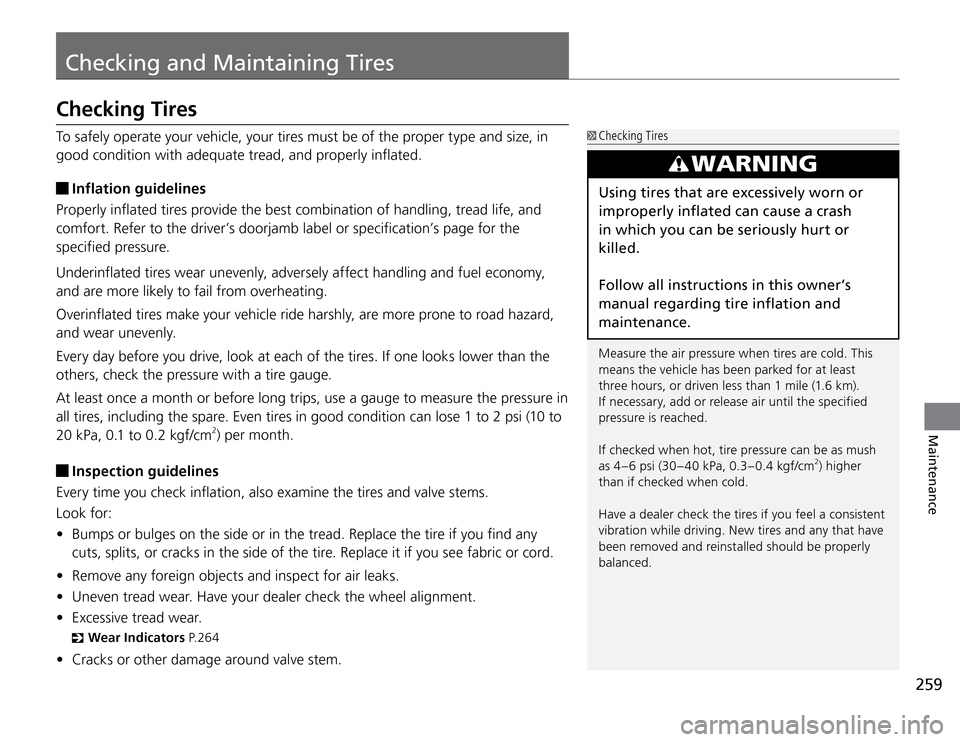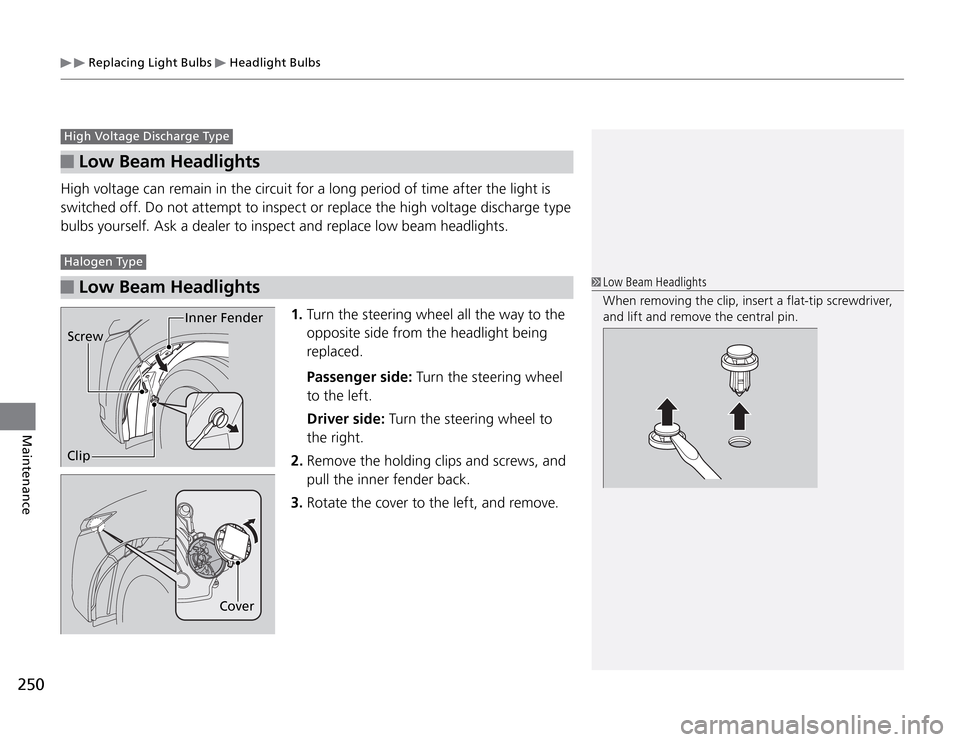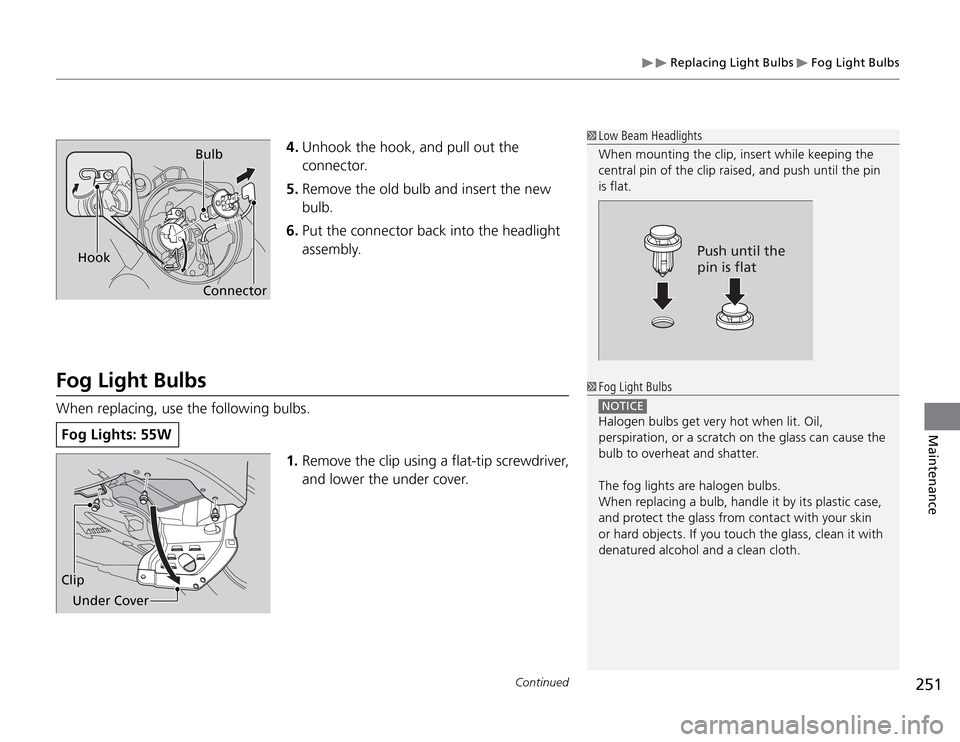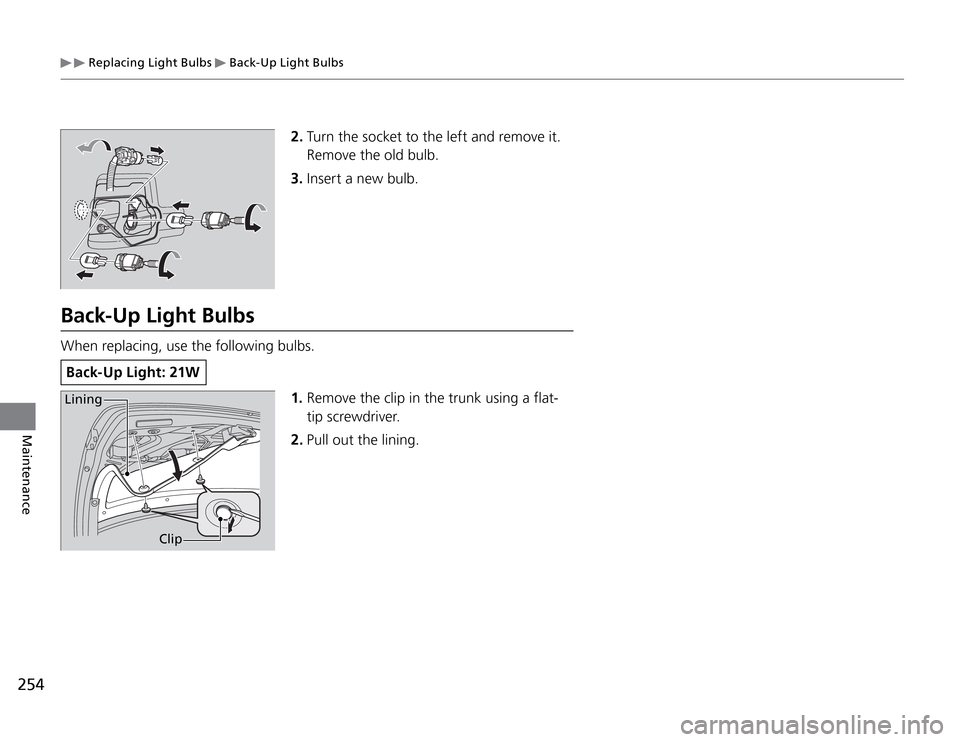Acura TSX 2011 Owner's Manual
Manufacturer: ACURA, Model Year: 2011,
Model line: TSX,
Model: Acura TSX 2011
Pages: 324, PDF Size: 7.85 MB
Acura TSX 2011 Owner's Manual
TSX 2011
Acura
Acura
https://www.carmanualsonline.info/img/32/11140/w960_11140-0.png
Acura TSX 2011 Owner's Manual
Trending: TPMS reset, manual radio set, wheel, fuel reserve, gas, airbag, height adjustment
Page 251 of 324
Replacing Light Bulbs
Headlight Bulbs
250Maintenance
Low Beam Headlights
1. Turn the steering wheel all the way to the
opposite side from the headlight being
replaced.
Passenger side: Turn the steering wheel
to the left.
Driver side: Turn the steering wheel to
the right.
2. Remove the holding clips and screws, and
pull the inner fender back.
3. Rotate the cover to the left, and remove.
Low Beam Headlights
High voltage can remain in the circuit for a long period of time after the light is
switched off. Do not attempt to inspect or replace the high voltage discharge type
bulbs yourself. Ask a dealer to inspect and replace low beam headlights.
Low Beam Headlights
When removing the clip, insert a flat-tip screwdriver,
and lift and remove the central pin.
High Voltage Discharge Type Halogen Type
Inner Fender
Screw
Cover Clip
Page 252 of 324
Replacing Light Bulbs
Fog Light Bulbs
251
Continued
Maintenance
4. Unhook the hook, and pull out the
connector.
5. Remove the old bulb and insert the new
bulb.
6. Put the connector back into the headlight
assembly.
Low Beam Headlights
When mounting the clip, insert while keeping the
central pin of the clip raised, and push until the pin
is flat.
Push until the
pin is flat
Fog Light BulbsWhen replacing, use the following bulbs.
Fog Lights: 55W
1. Remove the clip using a flat-tip screwdriver,
and lower the under cover.
Fog Light Bulbs NOTICE Halogen bulbs get very hot when lit. Oil,
perspiration, or a scratch on the glass can cause the
bulb to overheat and shatter.
The fog lights are halogen bulbs.
When replacing a bulb, handle it by its plastic case,
and protect the glass from contact with your skin
or hard objects. If you touch the glass, clean it with
denatured alcohol and a clean cloth. Hook
Connector Bulb
Clip
Under Cover
Page 253 of 324
Replacing Light Bulbs
Front Turn Signal/Parking/Side Marker Light Bulbs
252Maintenance
Front Turn Signal/Parking/Side Marker Light BulbsWhen replacing, use the following bulbs.
Front Turn Signal/Parking/Side Marker: 21/5WTurn the steering wheel and pull the inner fender back in the same way as when
replacing the low beam headlights.
Changing the Low Beam Headlight
�
P. 2 5 0
1. Turn the socket to the left and remove it.
2. Push in the old bulb, rotate to the left until
it unlocks, and remove.
3. Insert a new bulb.2. Remove the coupler.
It can be removed by pushing the tab.
3. Rotate the old bulb to the left to remove.
4. Insert new bulb.
BulbSocket
Bulb
Ta b
Coupler
Page 254 of 324
Replacing Light Bulbs
Side Turn Signal/Emergency Indicator Light Bulbs
253
Continued
Maintenance
Brake Light, Taillight, Rear Turn Signal Light and
Rear Side Marker Light BulbsWhen replacing, use the following bulbs.
Brake/Taillight: 21/5W
Rear Turn Signal Light: 21W
Rear Side Marker Light: 3CP
1. Pull out and remove the cover.
Side Turn Signal/Emergency Indicator Light BulbsDoor mirrors have the side turn lights. Have an authorized Acura dealer inspect
and replace the light bulbs.
Cover
Page 255 of 324
Replacing Light Bulbs
Back-Up Light Bulbs
254Maintenance
2. Turn the socket to the left and remove it.
Remove the old bulb.
3. Insert a new bulb.
Back-Up Light BulbsWhen replacing, use the following bulbs.
Back-Up Light: 21W
1. Remove the clip in the trunk using a flat-
tip screwdriver.
2. Pull out the lining.
Lining
Clip
Page 256 of 324
Replacing Light Bulbs
Rear License Plate Light Bulbs
255
Maintenance
3. Turn the socket to the left and remove.
4. Remove the old bulb and insert the new
bulb.
Rear License Plate Light BulbsHave an authorized Acura dealer inspect and replace the light bulbs.
Lining
Clip
Socket
Bulb
Page 257 of 324
Replacing Light Bulbs
High-Mount Brake Light Bulbs
256Maintenance
High-Mount Brake Light BulbsWhen replacing, use the following bulbs.
High-Mount Brake Light: 21W
1. Open the trunk.
2. Turn the socket to the left and remove it.
3. Remove the old bulb and insert the new
bulb.
BulbSocket
Page 258 of 324
257
Checking and Maintaining Wiper Blades
Continued
Maintenance
Checking Wiper BladesIf the wiper blade rubber has deteriorated, it will leave streaks and the metal wiper
arm may scratch the window glass.Changing the Wiper Blade Rubber
1. Lift the driver side wiper arms first, then
the passenger side.
2. Place a cloth on the edge of the lock tab.
Push the lock tab up with a flat-tip screw
driver.
3. Slide the blade from the wiper arm.
Changing the Wiper Blade Rubber NOTICE Avoid dropping the wiper blade; it may damage the
windshield.
Lock Tab
Page 259 of 324
Checking and Maintaining Wiper Blades
Changing the Wiper Blade Rubber
258Maintenance
4. Slide the wiper blade out from its holder
by pulling the tabbed end out.
5. Remove the retainer from the rubber blade
that has been removed, and mount to a
new rubber blade.
Correctly align the rubber protrusion
and the retainer groove.
6. Slide the new wiper blade onto the holder
from the bottom end. The tab on the blade should fit in the
indent of the wiper blade.
7. Slide the wiper blade onto the wiper arm,
then push down the lock tab.
8. Lower the passenger side wiper arm first,
then the driver side.
Blade
To p
Blade Retainer
Ta bIndent
Page 260 of 324

259
Checking and Maintaining Tires
Maintenance
Checking TiresTo safely operate your vehicle, your tires must be of the proper type and size, in
good condition with adequate tread, and properly inflated.
Inflation guidelines
Properly inflated tires provide the best combination of handling, tread life, and
comfort. Refer to the driver’s doorjamb label or specification’s page for the
specified pressure.
Underinflated tires wear unevenly, adversely affect handling and fuel economy,
and are more likely to fail from overheating.
Overinflated tires make your vehicle ride harshly, are more prone to road hazard,
and wear unevenly.
Every day before you drive, look at each of the tires. If one looks lower than the
others, check the pressure with a tire gauge.
At least once a month or before long trips, use a gauge to measure the pressure in
all tires, including the spare. Even tires in good condition can lose 1 to 2 psi (10 to
20 kPa, 0.1 to 0.2 kgf/cm
2) per month.
Inspection guidelines
Every time you check inflation, also examine the tires and valve stems.
Look for:
Bumps or bulges on the side or in the tread. Replace the tire if you find any �t
cuts, splits, or cracks in the side of the tire. Replace it if you see fabric or cord.
Remove any foreign objects and inspect for air leaks. �t
Uneven tread wear. Have your dealer check the wheel alignment. �t
Excessive tread wear. �t
Wear Indicators
�
P. 2 6 4
Cracks or other damage around valve stem. �t
WARNING
Using tires that are excessively worn or
improperly inflated can cause a crash
in which you can be seriously hurt or
killed.
Follow all instructions in this owner’s
manual regarding tire inflation and
maintenance. Checking Tires
Measure the air pressure when tires are cold. This
means the vehicle has been parked for at least
three hours, or driven less than 1 mile (1.6 km).
If necessary, add or release air until the specified
pressure is reached.
If checked when hot, tire pressure can be as mush
as 4 – 6 psi (30 – 40 kPa, 0.3– 0.4 kgf/cm
2) higher
than if checked when cold.
Have a dealer check the tires if you feel a consistent
vibration while driving. New tires and any that have
been removed and reinstalled should be properly
balanced.
Trending: compression ratio, seat memory, auxiliary battery, Pin code, remove seats, transmission fluid, Tire









